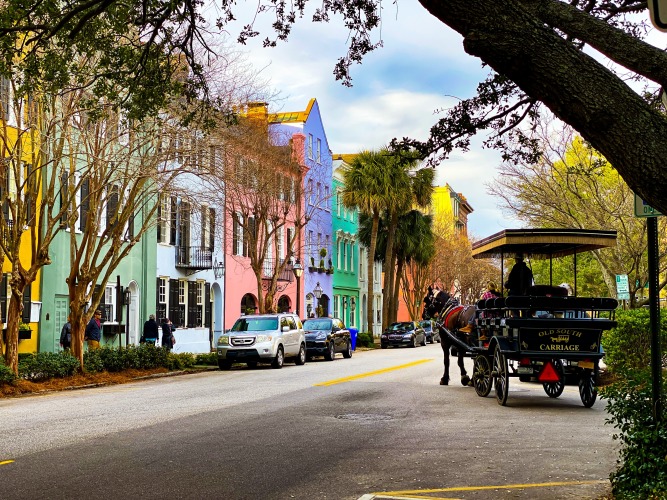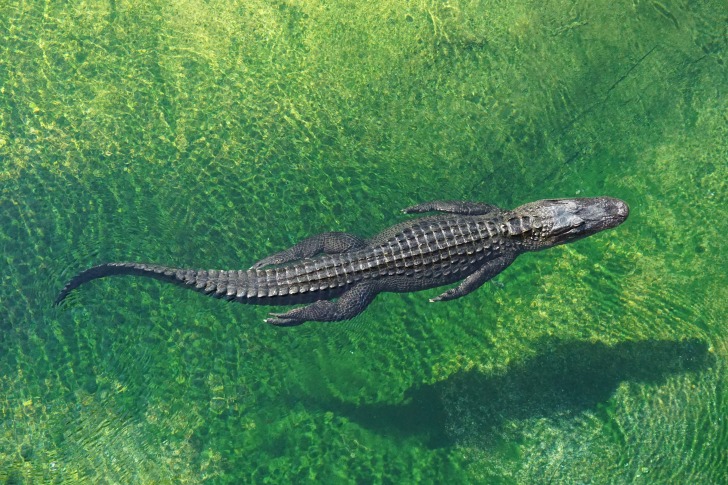South Carolina has an estimated 100,000 alligators, and the American alligator is the only species native to the southeastern US state.
There are many alligators in South Carolina, especially in Beaufort.
The largest alligator caught in South Carolina weighed 1,025 pounds, 13 feet 6 inches.
Game hunters found the gator in Lake Moultrie, known for housing the biggest gators in the state today.
There are alligators in South Carolina, and the populations are doing so well that South Carolina’s Department of Natural Resources instituted an alligator hunting season.

Contents
Alligator Species in South Carolina
The American alligator (Alligator mississippiensis) of the Family Alligatoridae is the only species native to South Carolina.
It is also the only alligator species available in South Carolina.
While previously listed as endangered, their populations have rebounded and are currently doing so well.
In 1989, the Department of Natural Resources initiated a program to allow contracted trappers to remove aggressive gators aggressive to domesticated animals and humans or invaded recreational areas.
As the population grew, the Department of Natural Resources initiated a hunting season, as plenty of the species existed.
Is it Safe to Swim in South Carolina?
While it is safe to swim in swimming pools in South Carolina, avoid swimming in natural waters, especially ones that are known to harbor reptiles.
They are common in lakes, streams, and rivers.
Swimming in these water sources often attracts alligators as they think a prey is injured when you splash.
Protective mothers can also attack instinct as they believe their nests or young ones are in danger.
Swimming between dusk and dawn puts you in danger, as the reptiles are active at night. If it is not a designated swimming area, other looming hazards include stumps, steep drop-offs, rocks, and other obstructions.
For safe swimming in South California, pay attention to swimming advisory signs warning against alligators before venturing into natural waters.
Avoid swimming after rain or during a storm as they often come out during rain.
Never swim alone, and be careful when around water; this is not only to give you a fighting chance against alligators but also as a standard safety precaution.
Swimming in areas with high human traffic is better as alligators often keep their distance.
Interesting Alligator Facts in South Carolina
Here are some interesting facts about the American alligator found in South Carolina.
1. The Most Popular Attraction in South Carolina
After dolphins, alligators are the most popular wildlife attraction in coastal areas of South Carolina.
The state is home to over 100,000 predators, which everyone visiting the state wants to see.
You can observe the reptiles from a distance or through safer means, like embarking on a guided alligator tour, visiting the South Carolina aquarium, or going for an alligator adventure.
2. Habitat
American alligators in South Carolina live in ponds, lakes, streams, rivers, and swamps.
While primarily freshwater animals, they can also venture into brackish salt water.
The predators can also stay underwater for up to 60 minutes regularly.
Though rarely, they can also stay underwater for 24 hours without coming up for air.
3. Mating and Nesting
The American alligator females lay up to 60 eggs, which they incubate in the rotting vegetation in the marshes.
The incubation period lasts about 65 days, during which the mothers defend the eggs against predators.
When the eggs hatch, they carry the young ones to the water.
They are active all year, but in South Carolina, they are most active during the warmer months.
They are also most aggressive during the mating and nesting seasons in the warm months.
4. There is Only One Species in South Carolina
The American and Chinese alligators are the only two alligator species in the world.
However, only American alligators are there in South Carolina.
They are keystone species as they shape the environment and other species’ lives.
For instance, digging gator holes provides freshwater for other species during droughts.
5. Lifespan
American alligators have a typical lifespan of about 30-50 years; alligators in captivity can live up to 80 years.
Some alligators die when much younger, and once they are about four feet long, they are safe from most predators apart from other alligators and humans.
6. They Can Have Up to 100 Teeth
Alligators in South Carolina have between 80 to 100 teeth.
The teeth are also replaced constantly throughout their life; when they wear down, new teeth grow in.
American alligators could go through 2000 teeth in their lifetime, as they get replaced if they break or wear down.
7. Lake Marion is the Most Alligator-Infested Lake
While alligators thrive in many lakes in South Carolina, Lake Marion is the most infested.
The lake extends over 110,600 acres and has coves and creeks, which alligators inhabit.
Over 100 alligators are confirmed to live in Lake Marion, and alligators weighing up to 1000 pounds are found in the lake.
8. They Can’t Live in Salt Water
Unlike crocodiles, the American alligator cannot survive in salt water.
They don’t have salt glands; they need these to excrete salt from their bodies and, therefore, cannot live full-time in saltwater bodies.
They venture into brackish salt water and move back and forth from freshwater to marine ecosystems to balance the salt levels in their bodies.
9. They Can Run
Alligators have a speed of about 10 miles per hour; however, they tend to tire quickly.
They don’t usually run on dry land and also don’t often outrun humans.
They are sprinters, and in water, they can go for up to 35 miles per hour.
Alligators swim fast as they use their muscular tails to prop themselves forward.
10. They Care for Offspring
Most reptiles don’t take care of their young ones.
Most of them abandon their eggs, and their young ones hatch later.
Alligators protect their eggs and take their young ones down into the water after hatching.
They protect them fiercely and will attack intruders if they believe they are a threat to their eggs.
They are among the few nurturing reptiles.

Differences Between Alligators and Crocodiles
South Carolina houses over 100,000 alligators but has crocodiles in smaller populations.
You can easily confuse the two different species as they belong to the same order.
Here is how you can tell them apart.
1. Shape of the Snout
The easiest way to tell an alligator apart from a crocodile is through the shape of the snout.
Alligators’ snouts are broader, larger, and U-shaped.
Crocodiles have V-shaped and pointed snouts.
All crocodile species have V-shaped snouts that could vary from narrow to broad but maintain the pointed shape. Crocodiles’ jaws also close from top to down.
2. Size
Crocodiles are typically more giant than alligators by about four to six feet.
On average, they are 10 to 20 feet long, varying from 300 to 2000 pounds.
Alligators are smaller, with most 8 to 11 feet long with a weight of 400 to 800 pounds, with the male alligators being larger than their female counterparts.
Saltwater crocodiles are the largest, as some reach up to 22 feet.
While the crocodiles are enormous, it is often challenging to tell the two species apart through their size, and it is difficult to eyeball.
3. Habitat
Alligators live in lakes, low-flowing rivers, ponds, and swamp lands; they prefer living closer to the shore.
They cannot survive in salt water, and the most they can do is move in and out of freshwater and saltwater ecosystems.
They can also live in cold areas, which is why you can find them in more states.
Crocodiles live in wetlands in, lakes and rivers, and marshes.
They can also live in fast-moving channels and saltwater ecosystems.
Alligators and crocodiles are cold-blooded, but crocodiles need warmer temperatures to thrive.
4. Species Size
There are only two alligator species, with the American alligator the only one available in South Carolina.
Crocodiles belong to the Crocodylidae family, which has 13 species.
5. Feet
Alligators have webbed feet that allow better swimming.
Crocodiles’ feet are not webbed, and they feature a jagged fringe.
6. Color
You can distinguish the two species through their color.
Crocodiles have shades of black, brown, grey, and green. Their bodies have mottled patterns, which help them blend well with substrate and algae.
Alligators are usually black or dark green and are generally darker than crocodiles.
In both species, the colors may vary depending on their habitats for camouflage when hunting.
3 Safety Tips for Swimming in Alligator-infested Waters
The rules surrounding safety in alligator-infested waters are straightforward:
1. Do Not Corner an Alligator
When you spot an alligator when swimming, avoid cornering alligators.
By so doing, you will make them feel threatened, and they may attack in defense.
Simply retreat and stay 30 feet away.
2. Swim in Designated Areas
If swimming is allowed in gator-infested waters, only do so in the designated areas.
3. Do Not Swim After Sunset
Most swimming areas with alligators close before sunset.
Alligators tend to be active between dusk and dawn; avoid swimming at night.
If you notice an alligator basking at the banks of a lake or pond, avoid feeding them.
If you hear an alligator hissing, it is a warning sign that you are too close for comfort; walk away.
Summary
While South Carolina has alligators and crocodiles, the state has more alligator populations.
The only native alligator species in the state is the American alligator which has a lifespan of up to 50 years and 80 years when domesticated.
Alligators and crocodiles belong to the same order but are different species.
The easiest way to tell them apart is through their snout shape, color, and size.
Alligators get aggressive when they feel threatened, and it is crucial to take the necessary safety precautions.
Avoid swimming in alligator-infested waters, cornering the reptiles, and feeding them.
If you spot them, keep a safe distance of not less than 30 feet.
South Carolina Safety Overview
READ THE FULL REPORT: South Carolina Safety Review
Safety Index:
- OVERALL RISK: MEDIUM
- TRANSPORT & TAXIS RISK: LOW
- PICKPOCKETS RISK: LOW
- NATURAL DISASTERS RISK: HIGH
- MUGGING RISK: MEDIUM
- TERRORISM RISK: MEDIUM
- SCAMS RISK: MEDIUM
- WOMEN TRAVELERS RISK: LOW
Frequently Asked Questions
Can You Hunt Alligators in South Carolina?
You can hunt alligators in South Carolina during the designated hunting season if you have a permit and harvest tag.
Can You Pet an Alligator in South Carolina?
Alligators prey on animals they can consume, making them dangerous animals to pet.
However, state-approved programs and individuals with proper permits and licenses can take them legally for management and control.
What do Alligators Eat?
Alligators are carnivorous and prey on any animals available.
Juvenile gators in South Carolina feed on snails, crustaceans, and small fish.
Adults eat mammals, birds, other alligators, and fish.











